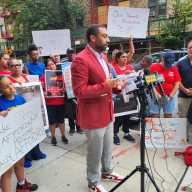Calvin Hemby didn’t know what awaited him following his 2019 prison release stemming from a fourth-degree grand larceny conviction, but his first goal was to find permanent housing.
For two years, Hemby tried his luck at numerous housing lotteries but no dice. He knocked on doors of housing agencies and even had housing referrals but still found himself on the outside looking in, worrying that his prior criminal history would prevent him from assimilating and making the most of his second chance.
Hemby, who has not reoffended, even spent five “hellish” months in the city’s shelter system, a mismanaged and onerous system that he says prompts those in the shelter system to try their luck on the streets and possibly fall back into old habits.
But the 65-year-old’s fortune changed in January when he received a call from nonprofit The Fortune Society, who offered him housing at The Trinity-Reverend William James Senior Apartments, a new multifamily senior residence in Morrisania with a unique housing mission: reserving housing for formerly homeless and incarcerated seniors.
“When I got that call, I couldn’t believe it. It felt like this was a second chance,” said Hemby. “Those of us who were in the grips of law enforcement or have never really had any resources or investment, we don’t live with certainty of housing or a safe secure place to come home to.”
The transformation of the former United Methodist Church site at 1074 Washington Ave., into housing for the city’s housing-needy populations was a project five years in the making and included a wealth of partners including United Methodist City Society, property developers Bronx Pro Group and the aforementioned nonprofit.

The Trinity-Reverend William James Senior Apartments stand at 12 stories, with 153 apartments and was an $88 million effort that includes amenities, a community space and an homage to its old United Methodist origins in both name and purpose.
All homes in the building are restricted to residents earning 60% of the area median income or lower; 96 of these units are being leased to a general senior populace; and one unit is designated for an on-site superintendent.
So far, 57 seniors, who have encountered homelessness and incarceration, as well as 86 seniors and spouses have already moved into the facility.
And when Hemby arrived to his six-floor apartment last week, he couldn’t ask for more. For the first time in Hemby’s life, he secured a second chance at both housing and peace of mind.
“I was happy. I couldn’t ask for more, because for so many years I felt isolated, lost and stuck without any connection or stability,” Hemby said. “I think people forget that when you get caught up in the criminal justice system and you’re trying to get everything right, it’s suffocating. For the first time in a long time, I can breathe.”
Housing and security does not come easy to seniors or those who have been formerly incarcerated as both groups experience homelessness at a heightened rate.
Research has consistently shown a strong link between incarceration and homelessness, such as a Prison Policy Initiative report that found formerly incarcerated people are almost 10 times more likely to be homeless than the general public. Other national data shows 50,000 people enter shelters directly from correctional facilities per year.
Two other formerly incarcerated and homeless tenants told the Bronx Times that their experiences in the city’s shelter system was “degrading,” expressing frustration with case workers who would often put them in inadequate housing.
“They put you in apartments that they wouldn’t live in and expect me to smile and say thank you even though it’s unliveable and distant from my support system,” said one tenant, who spent four years in the city’s shelter system and wished to remain anonymous.
The Fortune Society, which provides support to the formerly incarcerated, suggests that due to a lack of employment and educational access the homelessness rate among seniors and seniors who have been incarcerated is likely much higher in New York City.

“Our prison and jail population is aging, and as older individuals leave incarceration, they encounter a world very different from the one they left. On top of that, they are faced with mental health, physical health, trauma and substance use issues often exacerbated by years of incarceration,” said JoAnne Page, president and CEO of The Fortune Society.
The issue is further compounded by policies implemented by the New York City Housing Authority, which can bar people with criminal histories from entering public housing units regardless of the nature of their crimes.
Daniel W. Tietz, commissioner of the state Office of Temporary and Disability Assistance, said that widespread landlord discrimination plays a major factor in lack of housing options and security for those formerly incarcerated.
The Bronx has a growing senior population that has increased by 28% over the past decade, according to the most recent census data. Older adults account for 12% of the borough’s population, but housing options are dwindling.
With a “silver tsunami” approaching — the number of Americans aged 65 or older is projected to surpass 72 million in 2030 and 83 million in 2050 — housing projects like The Trinity-Reverend William James Senior Apartments are opening its doors to meet the need for housing for NYC’s gray generation.
The hope, according to project partners, is that the building can be a housing haven for 200 formerly incarcerated homeless seniors.
“As people of faith, we believe in transformation. In this case, we took an underutilized, crumbling church property and have made it into a beautiful new home for the seniors in this Bronx community,” said Bill Shillady, executive director at The United Methodist City Society, the social service arm of the church. “This is an excellent example of a faith and community partnership that creates mission-driven affordable housing that repurposes church property when a congregation ceases to exist and we use it for the benefit of the housing needs of seniors and especially formerly homeless returning citizens.”
As for the name that adorns the repurposed building? It’s a nod to Rev. Dr. William Marcus James, who served as the United Methodist Church pastor from 1944 until 1952. James is known for being an early champion for all, including gay and lesbian rights when homosexuality was scantly discussed in a progressive lens.
“Naming the building after him was an acknowledgment of how his outreach and advocacy made a difference in the community,” said United Methodist Church officials.
Reach Robbie Sequeira at rsequeira@schnepsmedia.com or (718) 260-4599. For more coverage, follow us on Twitter, Facebook and Instagram @bronxtimes





















